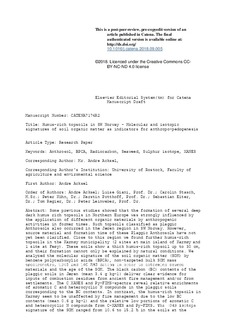| dc.contributor.author | Acksel, Andre | |
| dc.contributor.author | Giani, Luise | |
| dc.contributor.author | Stasch, Carolin | |
| dc.contributor.author | Kühn, Peter | |
| dc.contributor.author | Eiter, Sebastian | |
| dc.contributor.author | Potthoff, Kerstin | |
| dc.contributor.author | Regier, Tom | |
| dc.contributor.author | Leinweber, Peter | |
| dc.date.accessioned | 2019-04-11T09:10:50Z | |
| dc.date.available | 2019-04-11T09:10:50Z | |
| dc.date.created | 2018-10-09T08:20:51Z | |
| dc.date.issued | 2018-10-03 | |
| dc.identifier.citation | CATENA. 2018, 172 831-845. | nb_NO |
| dc.identifier.issn | 0341-8162 | |
| dc.identifier.uri | http://hdl.handle.net/11250/2594178 | |
| dc.description.abstract | Some previous studies showed that the formation of several deep dark humus-rich topsoils in Northern Europe was strongly influenced by the application of different organic materials by anthropogenic activities in former times. Such topsoils classified as plaggic Anthrosols also occurred in the Jæren region in SW Norway. However, source material and formation time of these Plaggic Anthrosols have not yet been clarified. Close to this region we found further humus-rich topsoils in the Karmøy municipality (2 sites at main island of Karmøy and 1 site at Feøy). These soils show a thick humus-rich topsoil up to 30 cm, and their formation cannot only be explained by natural conditions. We analyzed the molecular signature of the soil organic matter (SOM) by benzene polycarboxylic acids (BPCA), non-targeted bulk SOM mass spectrometry, δ34S and 14C AMS dating in order to determine source materials and the age of the SOM. The black carbon (BC) contents of the plaggic soils in Jæren (mean 3.4 g kg−1) deliver clear evidence for inputs of combustion residues from ancient fire management and/or from settlements. The C-XANES and Py-FIMS-spectra reveal relative enrichments of aromatic C and heterocyclic N compounds in the plaggic soils corresponding to the BC contents. In contrast, the humus-rich topsoils in Karmøy seem to be unaffected by fire management due to the low BC contents (mean 0.6 g kg−1) and the relative low portions of aromatic C and heterocyclic N compounds from C-XANES and Py-FIMS. The δ34S isotope signature of the SOM ranged from 10.6 to 15.2‰ in the soils at the islands and 10.0 to 13.5‰ in Jæren, corresponding to the Anthrosols in the Baltic Sea region (Median: δ34S = 11.5‰) and suggest an input of marine biomass (δ34S of seaweed = 20‰). The AMS 14C dating and complementary archaeological literature implied that the soils in Jæren and Karmøy have been formed between the Roman Iron Age (500 BC to AD 500) and the Viking Age (AD 800 to AD 1,000). Our results provide strong evidence for an anthropo-pedogenesis of the humus-rich topsoils in Karmøy and indicate parallels to the plaggic soils in Jæren as well as to Anthrosols in the Baltic Sea region. Therefore, we propose to classify the humus-rich topsoils in Karmøy as Anthrosols. | nb_NO |
| dc.language.iso | eng | nb_NO |
| dc.rights | Navngivelse 4.0 Internasjonal | * |
| dc.rights.uri | http://creativecommons.org/licenses/by/4.0/deed.no | * |
| dc.subject | Anthrosol | nb_NO |
| dc.subject | BPCA | nb_NO |
| dc.subject | Radiocarbon | nb_NO |
| dc.subject | Seaweed | nb_NO |
| dc.subject | Sulphur isotope | nb_NO |
| dc.subject | XANES | nb_NO |
| dc.title | Humus-rich topsoils in SW Norway – Molecular and isotopic signatures of soil organic matter as indicators for anthropo-pedogenesis | nb_NO |
| dc.type | Journal article | nb_NO |
| dc.type | Peer reviewed | nb_NO |
| dc.description.version | acceptedVersion | nb_NO |
| dc.rights.holder | © 2018 Elsevier B.V. All rights reserved | nb_NO |
| dc.subject.nsi | VDP::Landbruks- og Fiskerifag: 900::Landbruksfag: 910 | nb_NO |
| dc.source.pagenumber | 831-845 | nb_NO |
| dc.source.volume | 172 | nb_NO |
| dc.source.journal | CATENA | nb_NO |
| dc.identifier.doi | 10.1016/j.catena.2018.09.005 | |
| dc.identifier.cristin | 1618861 | |
| dc.relation.project | Norges forskningsråd: 194051 | nb_NO |
| cristin.ispublished | true | |
| cristin.fulltext | postprint | |
| cristin.qualitycode | 1 | |

